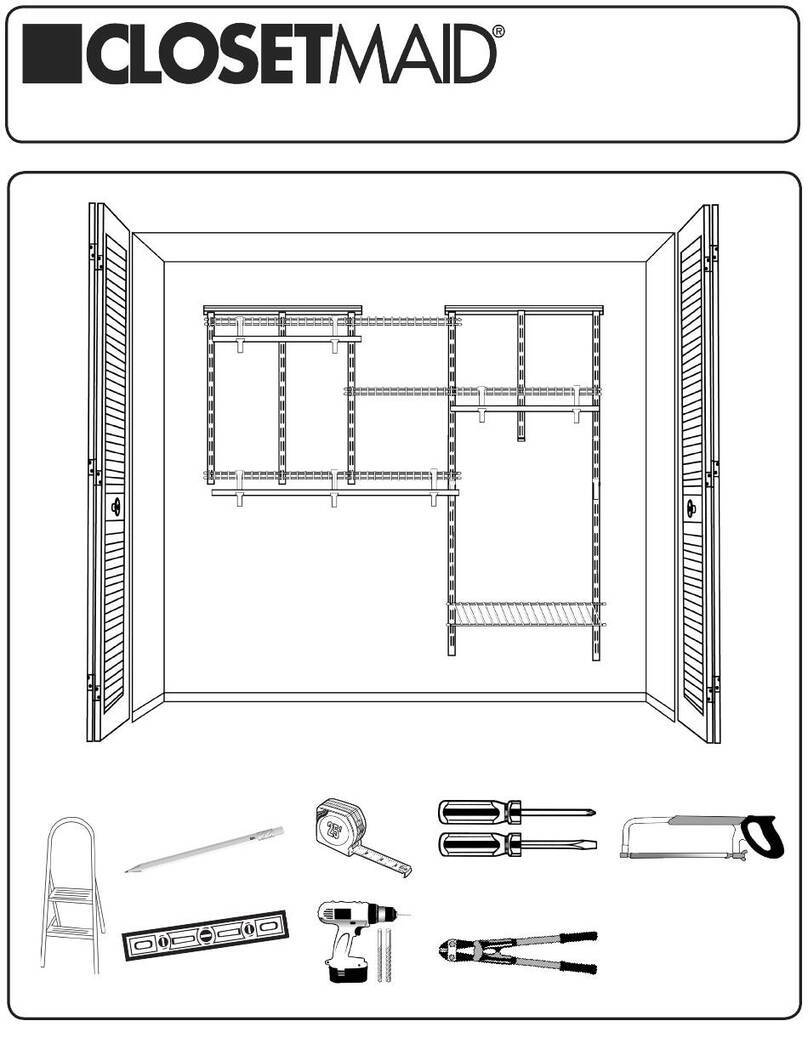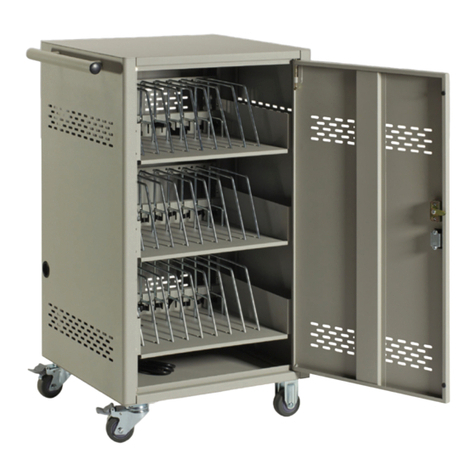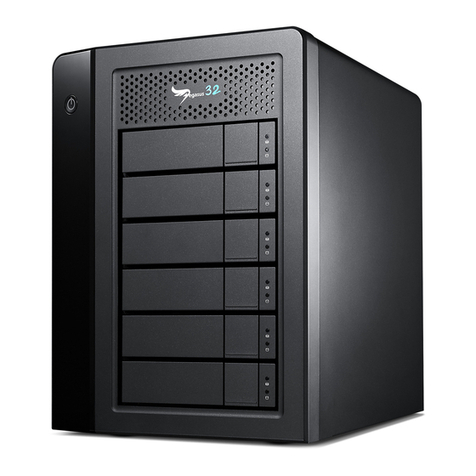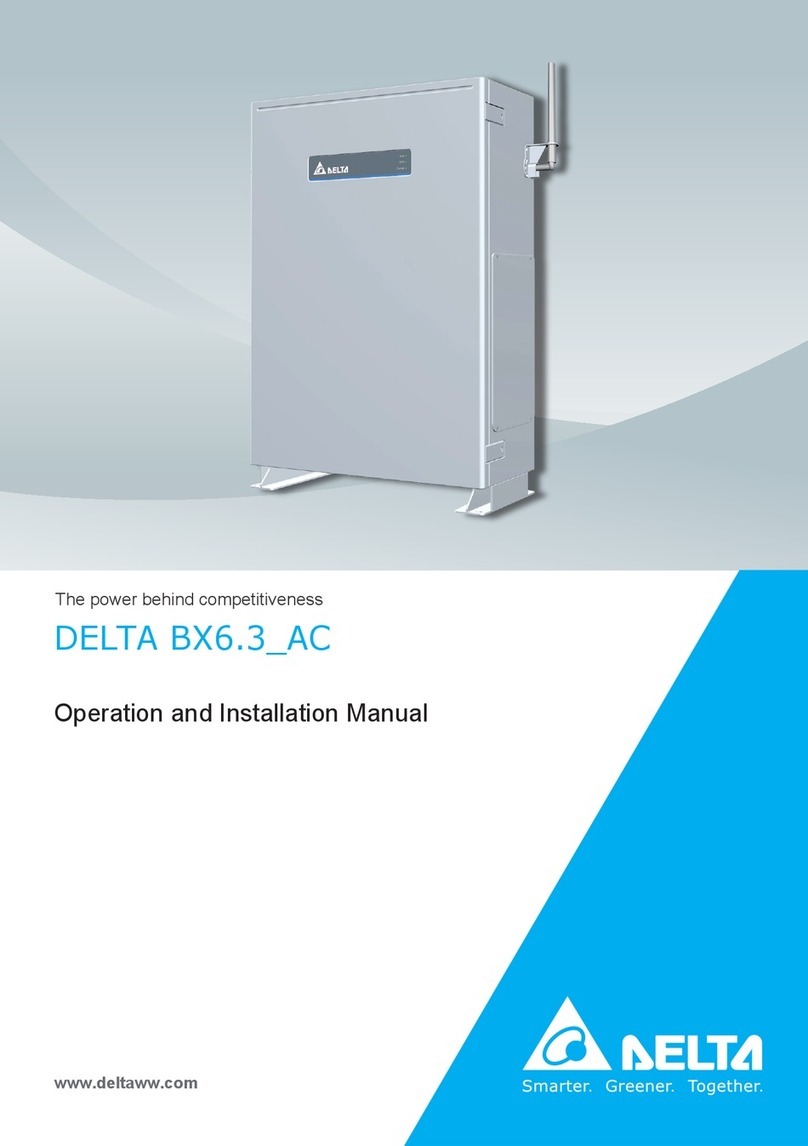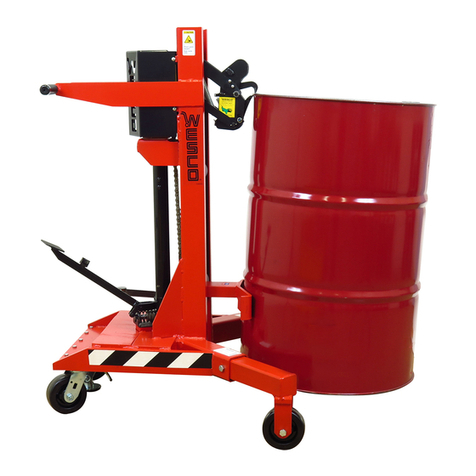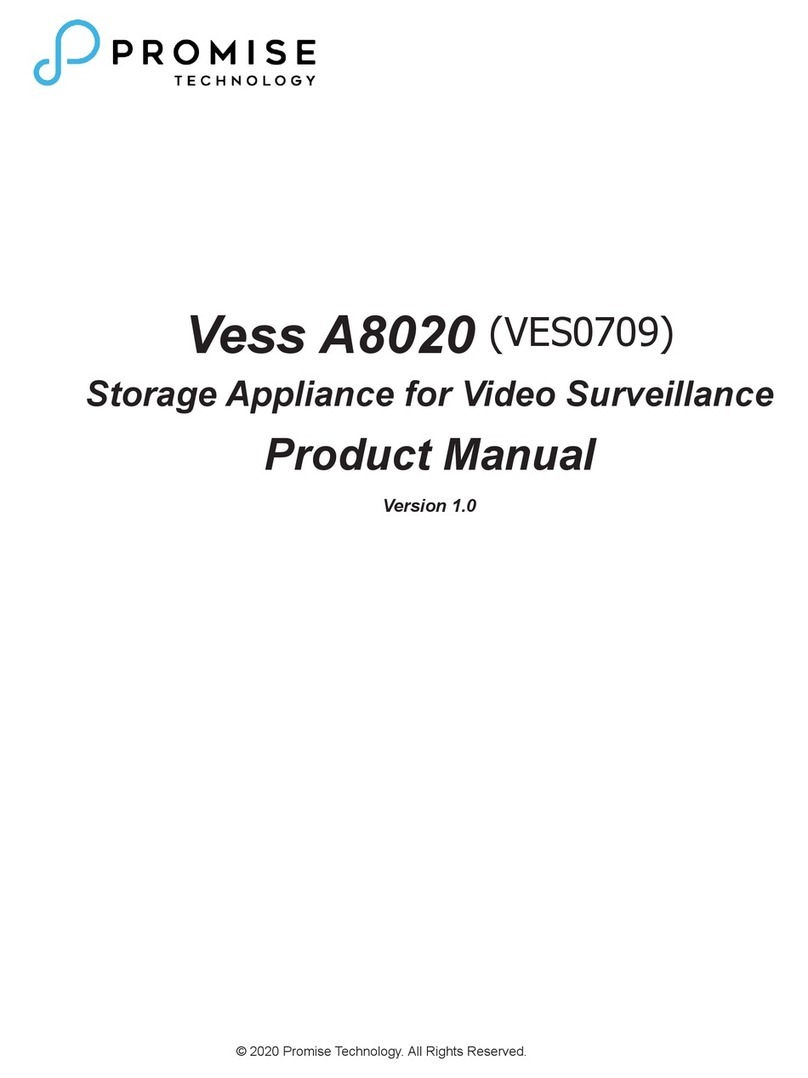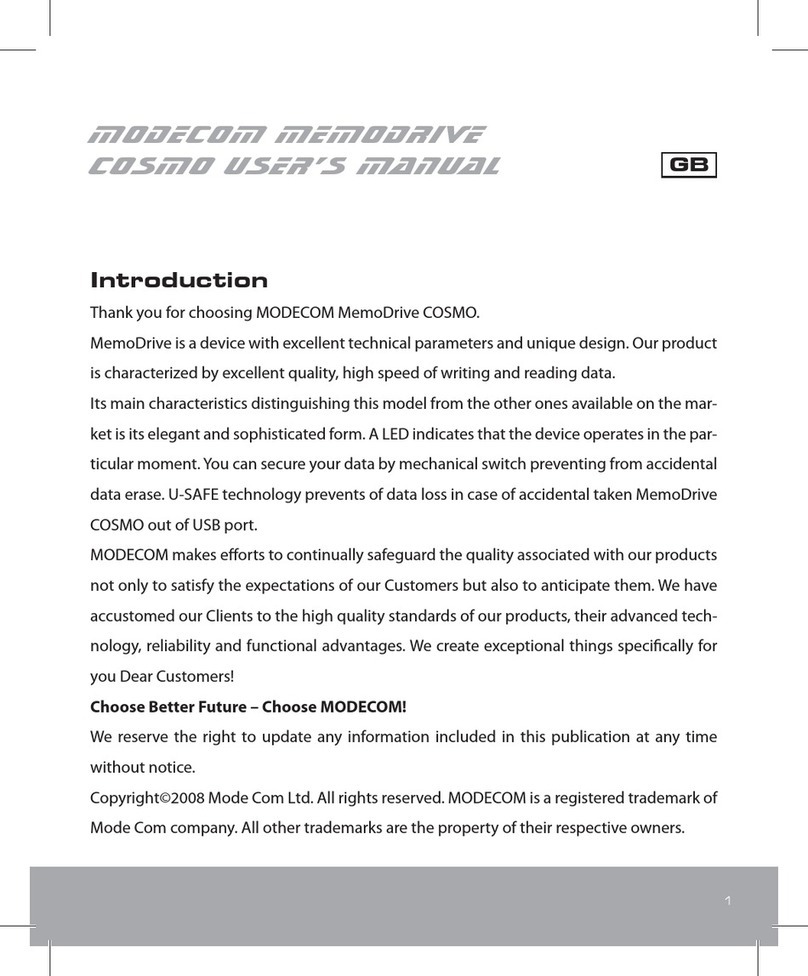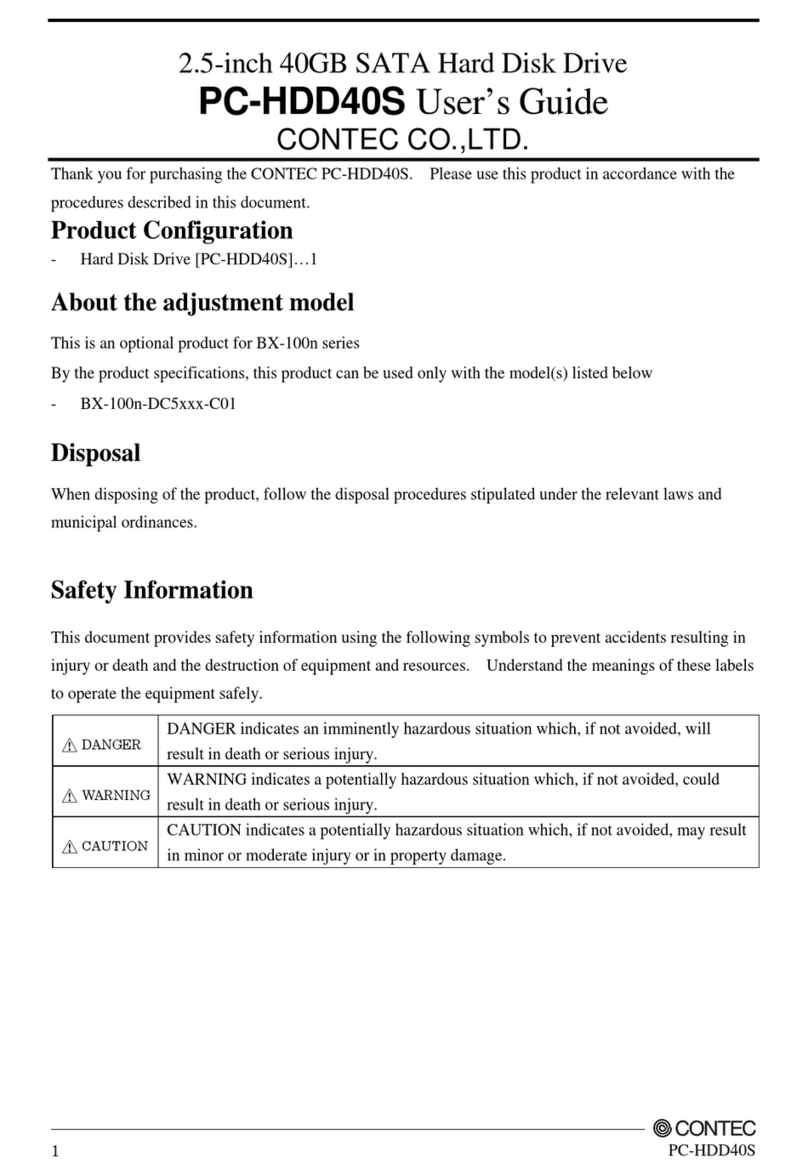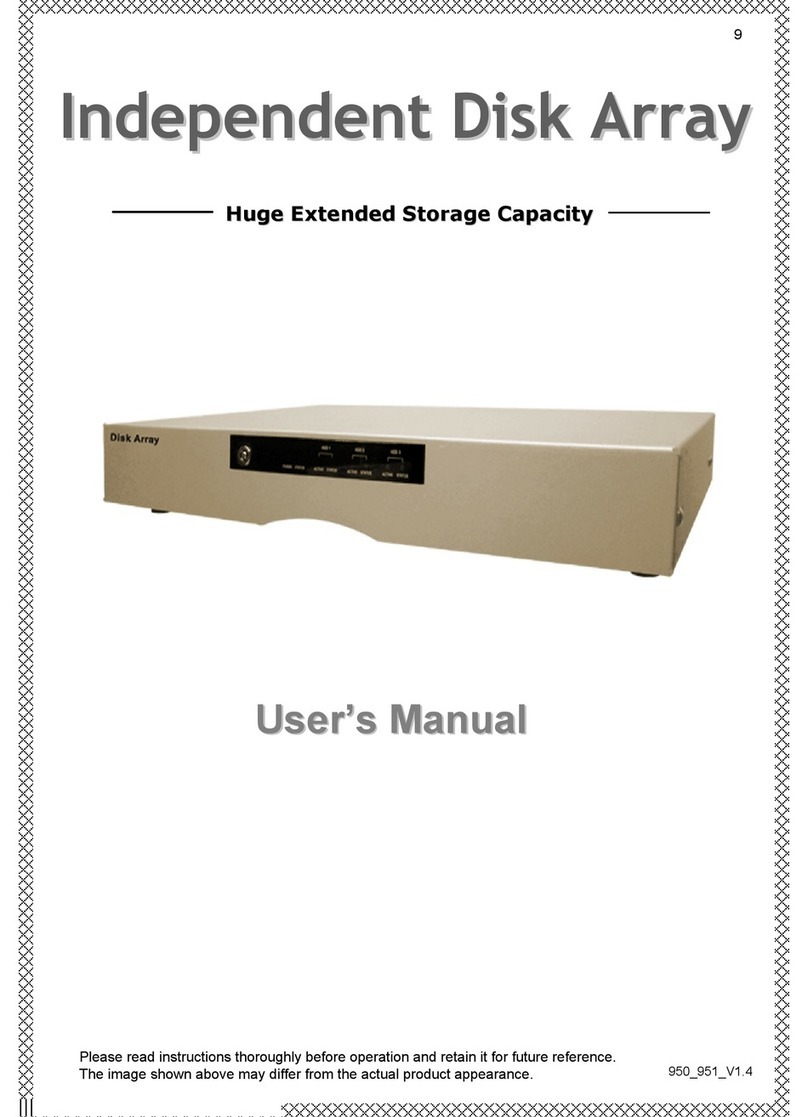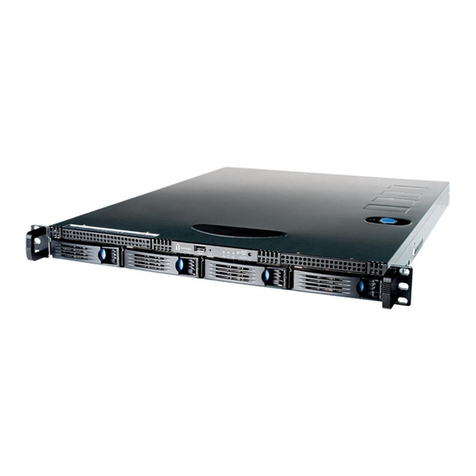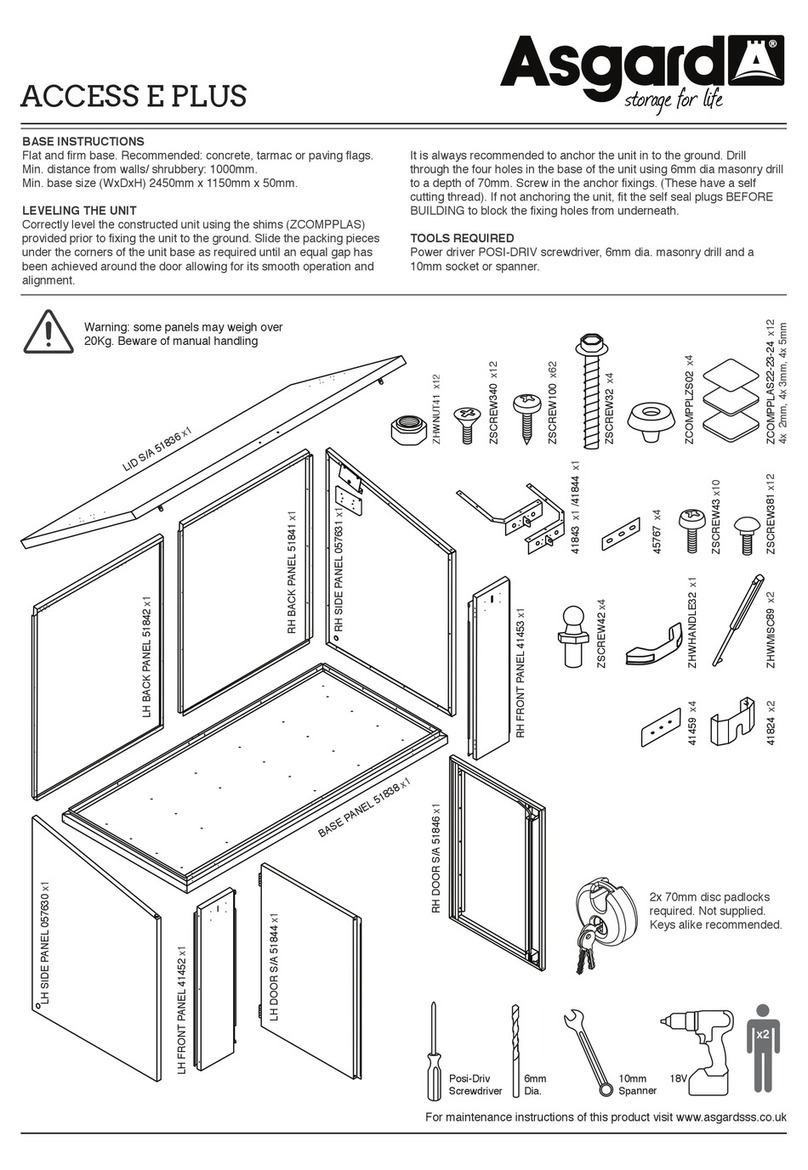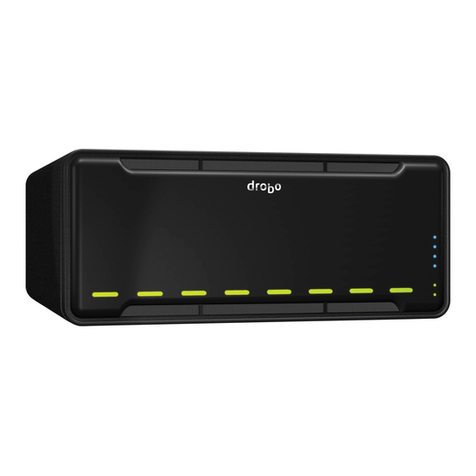Rorke Data Galaxy A16F-G2422 User manual

Galaxy Raid
Model A16F-G2422
FC-4G to SATA-II RAID Subsystem
Installation and Hardware
Reference Manual
Version 070106
Version 1.0 (08, 2005)

Galaxy Raid Installation and Hardware Reference Manual
ii
Contact Information
Americas
Rorke Data Inc
9700 West 76th St
Eden Prairie, MN 55344
USA
Tel: +1-800 328 8147
Fax: +1-952 829 0988
techsupport@rorke.com
http://www.rorke.com

Galaxy Raid Installation and Hardware Reference Manual
iii
Copyright 2005
This Edition First Published 2005
All rights reserved. This publication may not be reproduced, transmitted,
transcribed, stored in a retrieval system, or translated into any language or
computer language, in any form or by any means, electronic, mechanical,
magnetic, optical, chemical, manual or otherwise, without the prior written
consent of Rorke Data , Inc.
Disclaimer
Rorke Data makes no representations or warranties with respect to the
contents hereof and specifically disclaims any implied warranties of
merchantability or fitness for any particular purpose. Furthermore, Rorke
Data reserves the right to revise this publication and to make changes from
time to time in the content hereof without obligation to notify any person of
such revisions or changes. Product specifications are also subject to change
without prior notice.
Trademarks
Galaxy and the Galaxy logo are registered trademarks of Rorke Data , Inc.
PowerPC®is a trademark of International Business Machines Corporation
and Motorola Inc.
Solaris and Java are trademarks of Sun Microsystems, Inc.
All other names, brands, products or services are trademarks or registered
trademarks of their respective owners.

Galaxy Raid Installation and Hardware Reference Manual
iv
Warnings and Certifications
FCC (applies in the U.S. and Canada)
FCC Class A Note
This device complies with Part 15 of the FCC rules. Operation is subject to
the following two conditions: (1) this device may not cause harmful
interference, and (2) this device may accept any interference received,
including interference that may cause undesired operation.
NOTE:
This equipment has been tested and found to comply with the limits for a
Class A digital device, pursuant to Part 15 of the FCC Rules. These limits
are designed to provide reasonable protection against harmful interference
when the equipment is operated in a commercial environment. This
equipment generates, uses, and can radiate radio frequency energy and, if
not installed and used in accordance with the instruction manual, may cause
harmful interference to radio communications. Operation of this equipment
in a residential area is likely to cause harmful interference in which case the
user will be required to correct the interference at his own expense.
The changes or modifications not expressly approved by the party
responsible for compliance could void the user’s authority to operate the
equipment.
WARNING:
Use only shielded cables to connect I/O devices to this equipment.
You are cautioned that changes or modifications not expressly approved by
the party responsible for compliance could void your authority to operate the
equipment.
This device is in conformity with the EMC.

Galaxy Raid Installation and Hardware Reference Manual
v
CB
This device meets the requirements of the CB standard for electrical
equipment with regard to establishing a satisfactory level of safety for
persons using the device and for the area surrounding the apparatus. This
standard covers only safety aspects of the above apparatus; it does not cover
other matters, such as style or performance.
ITE BSMI Class A, CNS 13438 (for Taiwan)
This device is in conformit
y
with the CB safet
y
specifications.

Galaxy Raid Installation and Hardware Reference Manual
vi
Table of Contents
CHAPTER 1 INTRODUCTION
1.1. PRODUCT OVERVIEW.................................................................................................. 1-1
1.1.1 Product Introduction.......................................................................................... 1-1
1.1.2 Enclosure Chassis.............................................................................................. 1-2
1.1.2.1 Chassis Overview..............................................................................................................1-2
1.1.2.2 Physical Dimensions.........................................................................................................1-3
1.1.2.3 Front Panel Overview .......................................................................................................1-3
1.1.2.4 Hard Drive Numbering .....................................................................................................1-4
1.1.2.5 Rear Panel Overview.........................................................................................................1-4
1.1.2.6 Back-plane Board..............................................................................................................1-5
1.2. GALAXY COMPONENTS............................................................................................ 1-5
1.2.1 LCD Panel.......................................................................................................... 1-5
1.2.2 Drive Trays......................................................................................................... 1-6
1.2.3 RAID Controller Modules.................................................................................. 1-6
1.2.4 Controller Module Interfaces ............................................................................ 1-7
1.2.5 DIMM Modules.................................................................................................. 1-9
1.2.6 BBU .................................................................................................................... 1-9
1.2.7 PSUs................................................................................................................. 1-10
1.2.8 Cooling Modules.............................................................................................. 1-11
1.3. GALAXY MONITORING........................................................................................... 1-12
1.3.1 I2C bus ............................................................................................................. 1-12
1.3.2 LED Indicators................................................................................................. 1-12
1.3.3 Firmware (FW) and RAIDWatch GUI ............................................................ 1-13
1.3.4 Audible Alarms................................................................................................. 1-13
1.4. HOT-SWAPPABLE COMPONENTS............................................................................... 1-13
1.4.1 Hot-swap Capabilities...................................................................................... 1-13
1.4.2 Components...................................................................................................... 1-13
1.4.3 Normalized Airflow.......................................................................................... 1-14
CHAPTER 2 HARDWARE INSTALLATION
2.1. INSTALLATION OVERVIEW ................................................................................ 2-1
2.2. INSTALLATION PRE-REQUISITES...................................................................... 2-1
2.3. SAFETY PRECAUTIONS:....................................................................................... 2-2
2.3.1 Precautions and Instructions............................................................................. 2-2
2.3.2 Static-free Installation........................................................................................ 2-3
2.4. GENERAL INSTALLATION PROCEDURE.......................................................... 2-3
2.4.1 Installation Procedure Flowchart ..................................................................... 2-4
2.5. UNPACKING THE SUBSYSTEM........................................................................... 2-5
2.6. INSTALLATION OVERVIEW ................................................................................ 2-5
2.6.1 Pre-installed Components.................................................................................. 2-5
2.6.2 Uninstalled Components.................................................................................... 2-5
2.7. INSTALLING THE OPTIONAL BBU..................................................................... 2-6
2.7.1 BBU Installation Overview................................................................................ 2-6
2.7.2 BBU Warnings and Precautions........................................................................ 2-6

Galaxy Raid Installation and Hardware Reference Manual
vii
2.7.3 Installation Procedure ....................................................................................... 2-7
2.8. HARD DRIVE INSTALLATION............................................................................. 2-9
2.8.1 Hard Drive Installation Prerequisites............................................................... 2-9
2.8.2 SATA Drive Installation..................................................................................... 2-9
2.9. DRIVE TRAY INSTALLATION............................................................................ 2-10
2.10. RACK/CABINET INSTALLATION...................................................................... 2-12
CHAPTER 3 SUBSYSTEM MONITORING
3.1. SUBSYSTEM MONITORING OVERVIEW........................................................................ 3-1
3.2. STATUS-INDICATING LEDS......................................................................................... 3-2
3.2.1 Brief Overview of the LEDs............................................................................... 3-2
3.2.2 LCD Panel.......................................................................................................... 3-3
3.2.3 Drive Tray LEDs................................................................................................ 3-4
3.2.4 Controller Module LEDs ................................................................................... 3-5
3.2.5 LAN Port LEDs .................................................................................................. 3-6
3.2.6 BBU LED............................................................................................................ 3-7
3.2.7 PSU LEDs .......................................................................................................... 3-8
3.2.8 Cooling Module LEDs ....................................................................................... 3-9
3.3. AUDIBLE ALARM ...................................................................................................... 3-10
3.3.1 Default Threshold Values ................................................................................ 3-10
3.3.2 Failed Devices.................................................................................................. 3-11
3.4. I2C MONITORING...................................................................................................... 3-11
CHAPTER 4 SUBSYSTEM CONNECTION AND OPERATION
4.1 FC HOST CONNECTION PREREQUISITES ......................................................... 4-1
4.1.1 Choosing the Fibre Cables................................................................................ 4-1
4.1.2 FC Lasers........................................................................................................... 4-2
4.1.3 FC Speed Auto-detection ................................................................................... 4-2
4.1.4 SFP Transceivers............................................................................................... 4-2
4.2 TOPOLOGY AND CONFIGURATION CONSIDERATIONS............................... 4-3
4.2.1 Basic Configuration Rules................................................................................. 4-3
4.2.2 Fibre Channel Topologies ................................................................................. 4-3
4.2.3 Host-side Topologies.......................................................................................... 4-4
4.2.4 Unique Identifier................................................................................................ 4-4
4.2.5 ID/LUN Mapping............................................................................................... 4-4
4.3 SAMPLE TOPOLOGIES .......................................................................................... 4-5
4.3.1 Sample Topology – Clustered Hosts.................................................................. 4-5
4.3.2 Sample Topology – Direct-Attached.................................................................. 4-6
4.4 POWER ON ............................................................................................................... 4-6
4.4.1 Check List........................................................................................................... 4-7
4.4.2 Power On Procedure ......................................................................................... 4-7
4.4.3 Power On Status Check...................................................................................... 4-8
4.4.4 LCD Screen ........................................................................................................ 4-9
4.5 POWER OFF PROCEDURE................................................................................... 4-10
CHAPTER 5 SUBSYSTEM MAINTENANCE
5.1. OVERVIEW............................................................................................................... 5-1
5.1.1 Maintenance....................................................................................................... 5-1

Galaxy Raid Installation and Hardware Reference Manual
viii
5.1.2 General Notes on Component Replacement...................................................... 5-1
5.2. REPLACING CONTROLLER MODULE COMPONENTS ................................... 5-2
5.2.1 Overview............................................................................................................. 5-2
5.2.2 Notes on Controller Module Maintenance........................................................ 5-3
5.2.3 Removing the Controller Module ...................................................................... 5-3
5.2.4 Replacing the Controller Module...................................................................... 5-4
5.3. DIMM MODULE REPLACEMENT........................................................................ 5-6
5.3.1 DIMM Module Considerations.......................................................................... 5-6
5.3.2 DIMM Module Replacement Procedure............................................................ 5-6
5.4. REPLACING AFAULTY BBU................................................................................ 5-7
5.5. REPLACING AFAULTY PSU MODULE .............................................................. 5-9
5.5.1 PSU Module Overview....................................................................................... 5-9
5.5.2 Replacing the PSU Module.............................................................................. 5-10
5.6. COOLING MODULE MAINTENANCE ............................................................... 5-13
5.6.1 Cooling Module Overview............................................................................... 5-13
5.6.2 Replacing a Cooling Module........................................................................... 5-13
5.7. REPLACING AFAILED HARD DRIVE............................................................... 5-14
5.7.1 Hard Drive Maintenance Overview................................................................. 5-14
5.7.2 Replacing a Hard Drive................................................................................... 5-15
APPENDIX A UNINTERRUPTIBLE POWER SUPPLY
A.1. UNINTERRUPTIBLE POWER SUPPLY OVERVIEW .......................................................A-1
A.2. COMPATIBLE UPS SUPPLIES.....................................................................................A-1
A.3. SERIAL COMMUNICATION CABLES...........................................................................A-1
A.4. CONNECTING THE UPS TO THE SUBSYSTEM.............................................................A-2
A.4.1 Connect the PSU Module Power Cords..........................................................A-2
A.4.2 Set the Baud Rate.............................................................................................A-2
A.4.3 Connect COM2.................................................................................................A-2
A.5. POWER ON................................................................................................................A-3
A.6. UPS STATUS MONITORING.......................................................................................A-3
A.6.1 Normal Operational Status..............................................................................A-3
A.6.2 UPS Messages..................................................................................................A-3
A.6.3 UPS Message Summary...................................................................................A-4
APPENDIX B SPECIFICATIONS
B.1. TECHNICAL SPECIFICATIONS ....................................................................................B-1
B.2. CONTROLLER SPECIFICATIONS .................................................................................B-3
B.2.1 Configuration...................................................................................................B-3
B.2.2 Architecture......................................................................................................B-3
B.3. DRIVE TRAY SPECIFICATIONS...................................................................................B-4
B.4. POWER SUPPLY SPECIFICATIONS..............................................................................B-4
B.5. COOLING MODULE SPECIFICATIONS.........................................................................B-5
B.6. RAID MANAGEMENT ...............................................................................................B-5
B.7. FAULT TOLERANCE MANAGEMENT..........................................................................B-6
APPENDIX C SPARE PARTS AND ACCESSORIES
C.1. SPARE PARTS ............................................................................................................C-1
C.2. ACCESSORIES ............................................................................................................C-2

Galaxy Raid Installation and Hardware Reference Manual
ix
APPENDIX D PIN OUTS
D.1. SFP CONNECTOR PIN OUTS......................................................................................D-1
D.2. COM1 CABLE:DB9 AUDIO JACK PIN OUTS............................................................D-3
D.3. COM2 CABLE:DB9 AUDIO JACK PIN OUTS............................................................D-3
D.4. IFT-9011 NULL MODEM...........................................................................................D-4
D.5. ETHERNET PORT PIN OUTS.......................................................................................D-5
D.6. MAIN POWER ............................................................................................................D-5
Safety Precautions
Precautions and Instructions
•Prior to powering on the subsystem, ensure that the correct power range is being
used.
•The GALAXY subsystem comes with sixteen (16) drive bays. Leaving any of
these drive bays empty will greatly affect the efficiency of the airflow within the
enclosure, and will consequently lead to the system overheating, which can
cause irreparable damage.
•If a module fails, leave it in place until you have a replacement unit and you are
ready to replace it.
•Airflow Consideration: The subsystem requires an airflow clearance, especially
at the front and rear.
•Handle subsystem modules using the retention screws, eject levers, and the metal
frames/face plates. Avoid touching PCB boards and connector pins.
•To comply with safety, emission, or thermal requirements, none of the covers or
replaceable modules should be removed. Make sure that during operation, all
enclosure modules and covers are securely in place.
•Be sure that the rack cabinet into which the subsystem chassis will be installed
provides sufficient ventilation channels and airflow circulation around the
subsystem.
•Provide a soft, clean surface to place your subsystem on before working on it.
Servicing on a rough surface may damage the exterior of the chassis.
•If it is necessary to transport the subsystem, repackage all disk drives separately.
•Dual redundant controller models come with two controller modules that must
be installed into the subsystem. Single controller modules come with a single
controller module and a metal sheet is placed over the lower controller bay at the
rear of the subsystem. Since single controller modules cannot be upgraded, this
metal sheet should NEVER be removed.

Galaxy Raid Installation and Hardware Reference Manual
x
ESD Precautions
Observe all conventional anti-ESD methods while handling system
modules. The use of a grounded wrist strap and an anti-static work pad are
recommended. Avoid dust and debris in your work area.
About This Manual
This manual:
•Introduces the GALAXY RAID subsystem series.
•Describes all the active components in the subsystem.
•Provides recommendations and details about the hardware installation
process.
•Briefly describes how to monitor the subsystem.
•Describes how to maintain the subsystem.
This manual does not:
•Describe components that are not user-serviceable.
•Describe the configuration options of firmware, using terminal
emulation programs, or the RAIDWatch GUI software that came with
your subsystem.
•Give a detailed description of the RAID controllers embedded within
the subsystem.
Revision History
♦Initial release
Who should read this manual?
This manual assumes that its readers are experienced with computer
hardware installation and are familiar with storage enclosures.

Galaxy Raid Installation and Hardware Reference Manual
xi
Related Documentation
•User’s Operation Manual
•RAIDWatch User’s Manual
These two documents can be found in the product utility CD included with
your subsystem package.
Conventions
Naming
From this point on and throughout the rest of this manual, the GALAXY
series is referred to as simply the “subsystem” or the “system” and
GALAXY is frequently abbreviated as “GAL.”
Lists
Bulleted Lists: Bulleted lists are statements of non-sequential facts. They
can be read in any order. Each statement is preceded by a round black dot
“•.”
Numbered Lists: Numbered lists are used to describe sequential steps you
should follow in order.
Important information that users should be aware of is indicated with the
following icons:
NOTE:
These messages inform the reader of essential but non-critical
information. These messages should be read carefully as any directions
or instructions contained therein can help you avoid making mistakes.
CAUTION!
Cautionary messages should also be heeded to help you reduce the
chance of losing data or damaging the system.
IMPORTANT!
The Important messages pertain to use the GALAXY subsystem
introduced in this manual.

Galaxy Raid Installation and Hardware Reference Manual
xii
WARNING!
Warnings appear where overlooked details may cause damage to the
equipment or result in personal injury. Warnings should be taken
seriously.
Software and Firmware Updates
Please contact Rorke Data’s tech support (techsupport@rorke.com) for the
latest software or firmware updates.
Problems that occur during the updating process may cause unrecoverable
errors and system down time. Always consult technical personnel before
proceeding with any firmware upgrade.
NOTE:
The firmware version installed on your system should provide the
complete functionality listed in the specification sheet/user’s manual.
We provide special revisions for various application purposes.
Therefore, DO NOT upgrade your firmware unless you fully understand
what a firmware revision will do.

Index
Index-1
accessory items, 2-5
airflow clearance, 2-2
Airflow, 2-2
alarm, 3-2
ambient temperature, 4-7
audible alarm, 1-13, 3-2, 3-9, 3-10
audio jack cable, 2-5
audio jack-to-DB9 cable, A-1
authorized battery disposal sites, 2-6
auto-negotiate, speed, 1-7, 1-8
backplane, 1-1, 1-5
battery backup unit, 1-1
baud rate, A-2
BBU LED, 3-7
BBU module, 1-9
BBU Warnings, 2-6
BBU, 1-1, 4-7
bi-directional data link, 4-2
Cable connection, 4-7
Cabling, 2-1
capacity, 2-9
chassis, 1-2
COM port, 1-8
COM2, A-2
component check, 2-1
configuration, 1-3
controller lever, 1-9
controller module installation, 2-6
controller module maintenance, 5-3
controller module, 1-6, 3-3, 3-5, 3-6, 5-1, 5-2, 5-3,
5-4
controller module, remove, 5-3
controller module, replace, 5-4
cooling module LED, 3-7
cooling module maintenance, 5-13
cooling module side latches, 5-14
cooling module slot, 1-11
cooling module, 1-1, 1-5, 1-11, 3-3, 3-8, 5-1, 5-13
cooling module, replace, 5-13
copper cable, 4-1
Data Compare Errors, 5-15
DDR RAM DIMM module, 1-9, 5-2, 5-6
DIMM socket, 1-7
drive bays, 2-9
INDEX
drive channel, 1-9
drive ID, 1-4
drive tray front panel, 1-6
drive tray installation, 2-10
drive tray LED, 1-6, 3-4
drive tray maintenance, 5-14
drive tray, 1-6, 2-9, 2-10, 4-7, 5-15
Drive Trays, 3-3
dual-fan cooling module, 1-1
electrical earth connection, 2-2
electronic noise, 4-3
electrostatic discharge, 2-1
ESD damage, 2-3
Ethernet port, 1-8, 3-1, 3-6
event notification, 1-13
fabric topology, 4-4
failover software, 4-6
fan failure, 1-10
faulty module, 2-2
FC-AL, 4-3
Fibre cable, 4-1
firmware, 1-13, 3-1
front flap, 2-11, 5-15, 5-16
front panel, 1-3, 1-5
Full redundancy, 4-5, 4-6
functional integrity, 3-2
GUI, 1-13
handles, 5-14
handling precautions, 5-8
hard drive, 2-1, 2-9, 4-7, 5-1, 5-15
hard drives, replace, 5-15
Hardware Manual, 2-5
HBA, 4-4
host channel, 1-1, 1-7
host computer, 1-8, 4-5, 4-6
hot-swap mechanism, 1-5, 5-1
hot-swappable components, 1-13
I/O access, 4-10
I/O traffic, 4-5, 4-6
I2C bus, 1-12, 3-2, 3-10
initial screen, 1-5
installation procedure flowchart, 2-4
interface board, 1-4
international transportation regulation, 1-9

Galaxy Raid Installation and Hardware Reference Manual
Index-2
key-lock, 5-16
LAN Port LED, 3-6
laser types, 4-2
LC connector, 4-2
LCD panel, 1-3, 1-5, 3-2, 3-3
LCD Screen, 4-9
LCD, 4-9
LED, 1-12, 3-2
lower level, 2-5
LUN mapping, 4-4
main power source, 5-10
maintenance, 5-1
media scan, 4-10
memory capacity, 1-9, 5-6
memory module, 4-7, 5-1
monitoring methods, 1-12
monitoring, 3-1, 5-1
mute button, 3-3
Non-OFC laser, 4-2
normalized airflow, 1-14, 5-2
null modem, 2-5
numbering of drive trays, 1-4
OFC laser, 4-2
operational integrity, 3-2
optical cable, 4-1
Optical Fibre Control, 4-2
over-voltage, 1-10
Partner Fail, 3-6
PC hyper-terminal, 3-1, 3-2, A-1
permanent IP, 3-6
physical dimensions, 1-3
points of failure, 4-4
Point-to-Point, 4-3
power cable, 5-10
power cord, 4-7
power down, 4-10
power on sequence, 4-7
power on status check, 4-8
power on, 4-6, A-3
power outlet, 2-2
power range, 2-2
power socket, 4-7
power supply unit, 1-1, 1-4
power switch, 1-4, 4-8
Pre-installed Components, 2-5
PSU Bracket, 5-9
PSU module maintenance, 5-9
PSU module, 1-1, 3-3, 5-1
PSU module, replace, 5-10
PSU printing mark, 5-9
PSU, 1-4, 1-10, 3-7, 5-10
quick installation guide, 2-5
rack cabinet, 2-2
RAIDWatch User’s Manual, 2-5
RAIDWatch, 1-13, 3-1
rear panel, 1-4, 1-5
Regenerating logical drive parity, 4-10
retention screws, 2-2
RJ-45, 3-6
safety precaution, 2-2, 5-3
SATA chip, 1-1
SATA drive installation, 2-9
SATA hard drive, 1-1
SATA-I drives, 2-9
SATA-II drives, 2-9
self-monitoring features, 3-1
sensors, 3-8
SFP connector, 1-7
SFP module, 1-8
SFP transceivers, 2-2, 4-2
signal quality, 4-3
startup, 4-9
static electricity, 2-3
static free installation environment, 2-1
status checking, 1-3
status-indicating LEDs, 3-2
storage network, 4-5, 4-6
subsystem downtime, 5-1
temperature threshold, 3-2
terminal emulation program, 1-13
the controller board, 3-2
thermal notice, 2-2
troubleshooting, 1-3
Uninstalled Components, 2-5
unique identifier, 4-4
Unpacking Checklist, 2-5
unpacking, 2-5, 5-1
upper level, 2-5
UPS Messages, A-3
UPS, A-1
User’s Operation Manual, 2-5, 3-1, 3-9, 4-9
ventilation, 2-2
VT-100 terminal, 1-8
wavelengths, 4-2
white clips, 5-7
working integrity, 5-1

Chapter 1: Introduction
Product Overview 1-1
Chapter 1
Introduction
1.1. Product Overview
1.1.1 Product Introduction
This hardware manual briefly introduces the Galaxy Fibre-4G to SATA-II
storage subsystem shown in Figure 1-1. Through this manual, you will gain
the knowledge of each hardware components, installation procedures,
monitoring functions, connection topologies and hardware maintenances.
The GALAXY subsystem comes with single Fibre to SATA RAID
controller and provides two
(2) 4Gbps (FC-4G) host
channels. Two (2) onboard
SATA chips provide
sixteen (16) 3Gbps SATA-
II drive channels that can
support up to sixteen (16)
SATA-II hard drives. The controller board has a pre-installed 256MB DDR
RAM DIMM module and can support a memory module with a capacity up
to 2GB.
The metal container in which the controller board is pre-installed is referred
to as the “controller module.” The controller module is accessed through the
rear of the GALAXY and is comprised of a PCB board, a rear faceplate, and
a metal canister. An optional battery backup unit (BBU) can be installed in
the upper left side of the controller module when viewed from the rear of the
subsystem. The independent BBU is also accessible and hot swappable
through the rear panel of the GALAXY.
I/O signals/commands transmitted between the controller and drives at the
front of the subsystem pass through a non-user-serviceable backplane board.
The backplane is connected to a maximum of sixteen (16) hard drives that
you purchase separately and install into the sixteen (16) drive trays that
come with the subsystem. The drive trays, which must be installed in the
drive bays, accommodate SATA-II hard drives (backward compatible to
SATA-I).
Two (2) redundant, hot-swappable, dual-fan cooling modules protect the
subsystem from overheating and two (2) redundant, hot-swappable, 2U
460W power supply units (PSUs) provide constant power to the subsystem.
Figure 1-1: A16F-G2422 Subsystem

Galaxy Raid Installation and Hardware Reference Manual
1-2 Product Overview
The modular nature of the subsystem and the easy accessibility to all major
components ensure the ease of the subsystem maintenance.
NOTE:
On receiving and unpacking your subsystem, please check the package
contents against the included Unpacking List. If any modules are missing,
please contact your subsystem vendor immediately.
1.1.2 Enclosure Chassis
1.1.2.1 Chassis Overview
The GALAXY RAID storage subsystem chassis is an enhanced 3U metal
chassis divided into front and rear sections, which are respectively accessed
through front and rear panels. Pre-drilled mounting holes in the sides of the
3U RAID subsystem enclosure allow you to attach separately purchased
slide rails so that you can install the enclosure into a rack or cabinet. Please
see Figure 1-2 for the components’ locations in the subsystem and read the
following sections for the front and rear panels descriptions.
Figure 1-2: GALAXY Subsystem Overview
NOTE:
Components accessed through the front panel are referred to as “Front
Panel Components” and components accessed through the rear panel are
referred to as “Rear Panel Components.”

Chapter 1: Introduction
Product Overview 1-3
1.1.2.2 Physical Dimensions
The GALAXY comes in an enhanced 3U chassis with the following
dimensions:
•With handles: 482.6mm x 131mm x 504.3mm (19 x 5.2 x 19.9
inches) (width x height x depth)
•Without handles: 445mm x 130mm x 488.2mm (17.5 x 5.1 x 19.2
inches) (width x height x depth)
1.1.2.3 Front Panel Overview
The front section of the subsystem features a 4x4 layout for sixteen (16) 3.5-
inch drives. The two (2) handles on the front of the subsystem enable you to
easily insert/extract the chassis into/from a rack or cabinet. The LCD panel
on the left handle provides an easy way for you to monitor and configure
your subsystem.
The front panel of the GALAXY RAID subsystem described in this manual
is shown in Figure 1-3.A description of each front panel component is
given below:
Figure 1-3: GALAXY Front View
The front panel shown in Figure 1-3 accommodates the following
components:
•Drive bays with drive tray canisters: The subsystem has sixteen
(16) drive bays in the front side of the chassis to house sixteen (16)
hard drives.
•Right handle and left handle with LCD panel: These front handles
are conveniently placed and simplify moving the subsystem
enclosure into and out of a rack or cabinet. The left side front-
handle houses a 16x2 character LCD panel that can be used for
subsystem configuration, troubleshooting and status checking.
(Please refer to Section 1.2.1)

Galaxy Raid Installation and Hardware Reference Manual
1-4 Product Overview
1.1.2.4 Hard Drive Numbering
The front panel of the GALAXY enclosure houses sixteen (16) hard drives
in a 4x4 configuration as shown in Figure 1-4. When viewed from the front,
the drive bays (slots) are numbered 1 to 16 from top to bottom, from left to
right.
Figure 1-4: Hard Drive Numbering
1.1.2.5 Rear Panel Overview
The rear section of the GALAXY subsystem is accessed through the rear
panel and is reserved for single RAID controller module, an optional BBU,
two (2) power supply units (PSUs), and two (2) cooling modules. A metal
sheet covers the lower section of controller model slot and BBU slot.
The rear panel of the GALAXY described in this manual is shown in Figure
1-5.A description of each rear panel component is given below:
Figure 1-5: GALAXY Rear View
The rear panel shown in Figure 1-5 accommodates the following
components:
•RAID controller module:A single controller module is installed in
the GALAXY . The controller module contains a RAID controller
board, interface board, DDR RAM DIMM module which provide
the system RAID functionalities. (See Section 1.2.3.)
•BBU: An independent BBU sustain cache memory during a power
shortage to prevent data loss. (See Section 1.2.6.)
•PSUs: The hot-swappable PSUs provide power to the subsystem.
A power switch is located on the right of each PSU to turn the
system on and off. (See Section 1.2.7.)

Chapter 1: Introduction
GALAXY Components 1-5
•Cooling modules: The redundant cooling modules provide
ventilation to reduce the temperature within the subsystem. (See
Section 1.2.8.)
1.1.2.6 Back-plane Board
Internal backplane boards separate the front and rear sections of the
GALAXY. The PCB board provides logic level signals and low voltage
power paths. They contain no user-serviceable components.
1.2. GALAXY Components
The GALAXY houses many active components and most of them can be
accessed through either the front or rear panel. The modular design of the
active components facilitates their easy installation and removal. Hot-swap
mechanisms are incorporated to eliminate power surges and signal glitches
that might occur while removing or installing these modules. Each
component is further described below:
1.2.1 LCD Panel
Figure 1-6: LCD Panel
The LCD panel shown in Figure 1-6 consists of a 16x2-character LCD
screen with push buttons and LED status indicators. The LCD front panel
provides full access to all RAID configuration settings and monitoring
functions. After powering up the subsystem, the initial screen will show the
subsystem model name. A different name may be assigned for the
subsystem, controller or different logical drive. This will enable easier
identification in a topology with numerous arrays.
1.2.2 Drive Trays

Galaxy Raid Installation and Hardware Reference Manual
1-6 GALAXY Components
Figure 1-7: Drive Tray
Each GALAXY subsystem comes with sixteen (16) drive trays. The front
panel of each drive tray (see Figure 1-7) contains a locking mechanism that
secures the drive tray to the enclosure and a latch that facilitates the removal
and installation of the drive tray. Two (2) status-indicating LEDs are also
located on the front of the drive tray. Retention screw holes are located on
the sides of the drive tray. These holes are reserved for securing hard drives
to the tray. Other retention screw holes are located on the surface of the tray
at the rear.
WARNING!
Be careful not to warp, twist, or contort the drive tray in any way (e.g., by
dropping it or resting heavy objects on it). The drive tray has been
customized to fit into the drive bays in the ES subsystem. If the drive bay
superstructure is deformed or altered, the drive trays may not fit into the
drive bay.
1.2.3 RAID Controller Modules
Figure 1-8: Controller Module
The RAID controller module that shipped with your subsystem contains a
metal bracket, a main circuit controller board, a management rear panel, and
a pre-installed 256MB capacity or above DDR RAM DIMM module. (See
Figure 1-8) The controller module contains no user-serviceable
components. Except when installing/upgrading the cache memory inside,
the controller module should never be removed or opened.
WARNING!
Although the RAID controller can be removed, the only time you should
touch the controller itself is to install the memory modules. The RAID
controller is built of sensitive components and unnecessary tampering can
damage the controller.
Table of contents
Other Rorke Data Storage manuals

Rorke Data
Rorke Data Galaxy GHDX2 ADA User manual
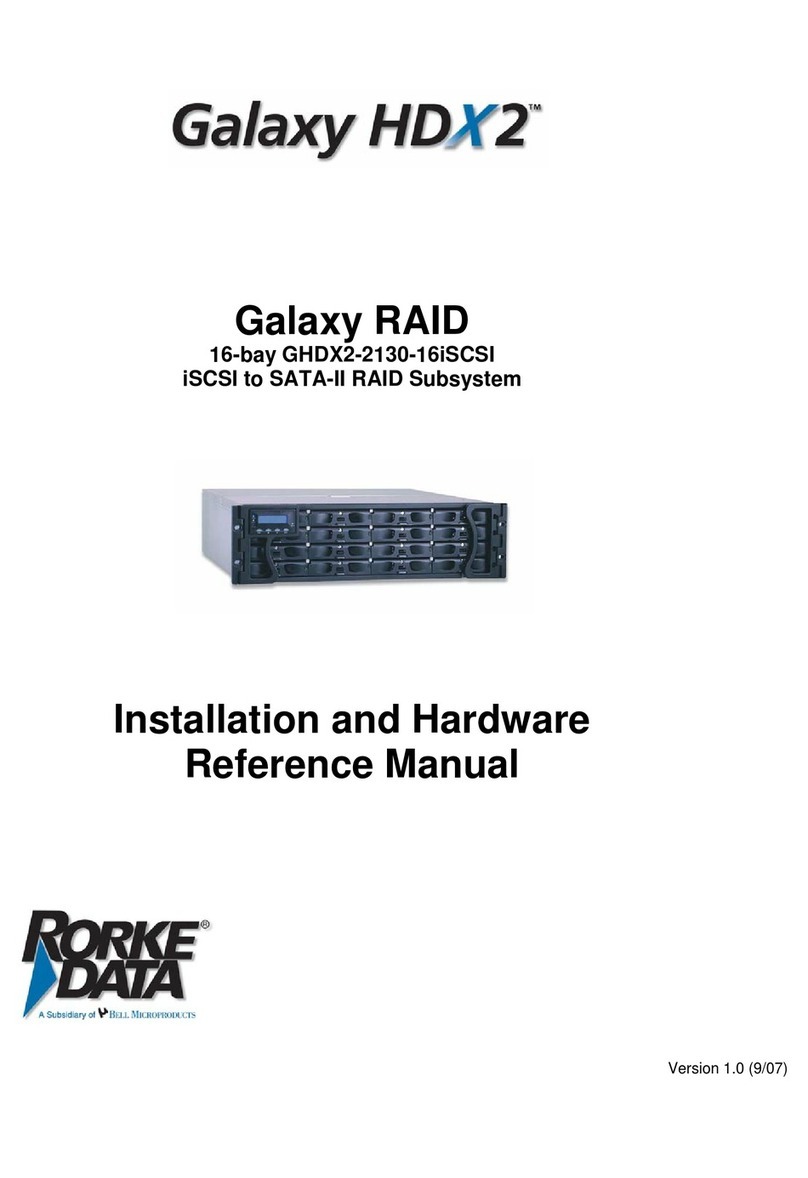
Rorke Data
Rorke Data Galaxy RAIDGHDX2-2130-16iSCSI User manual
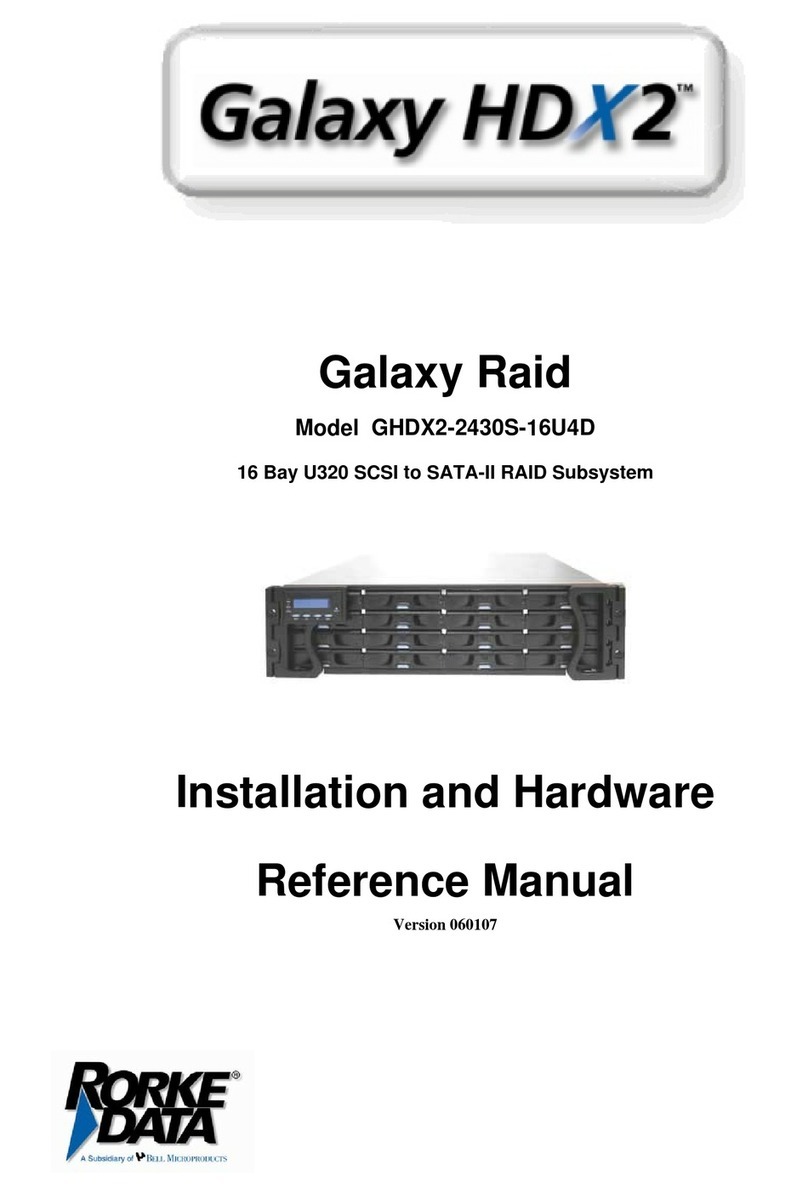
Rorke Data
Rorke Data Galaxy HDX2-2430S-16U4D User manual
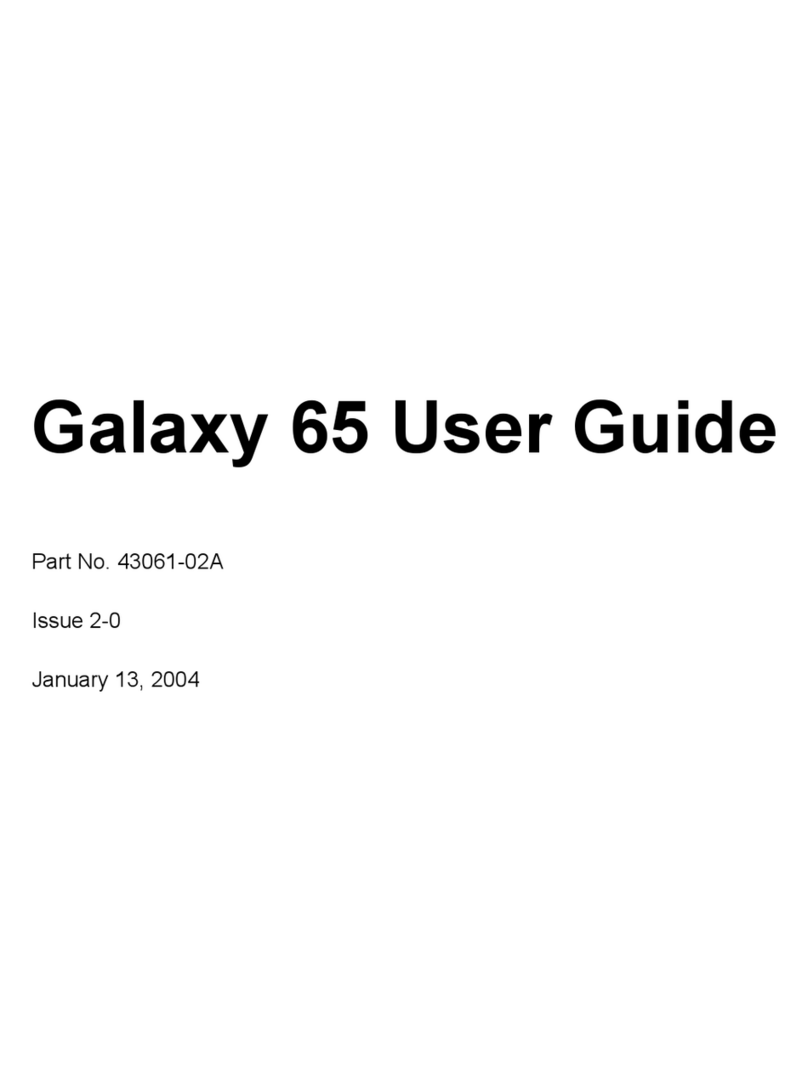
Rorke Data
Rorke Data The Galaxy 65 User manual
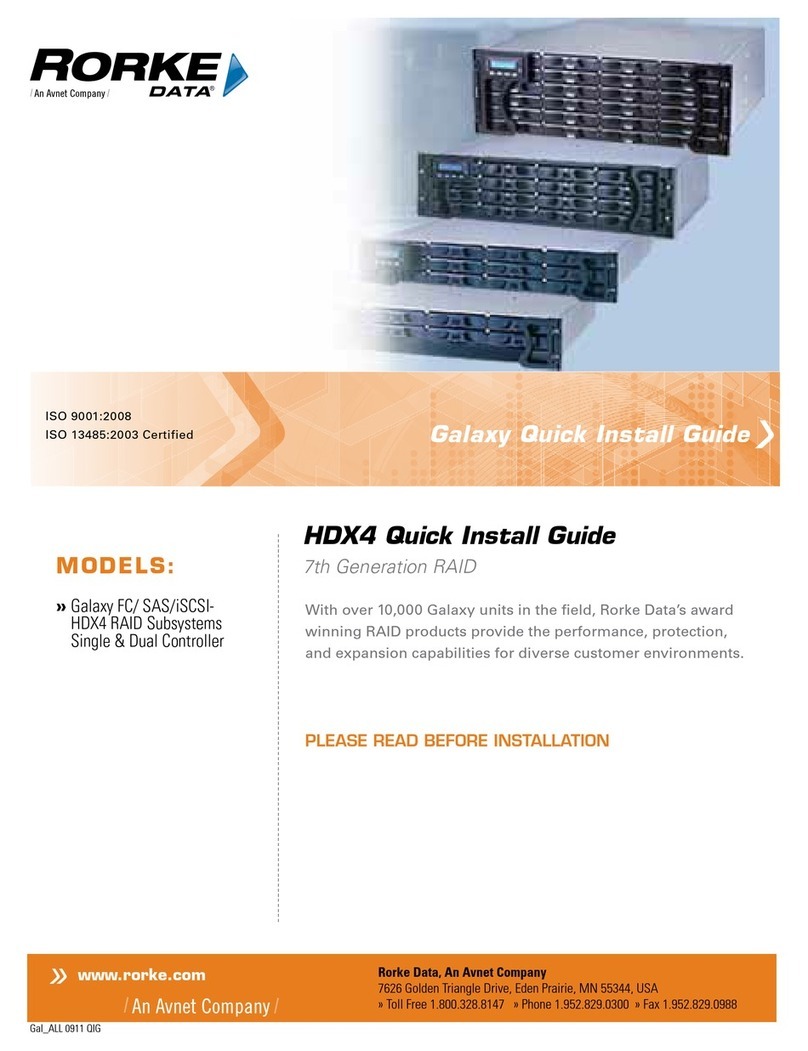
Rorke Data
Rorke Data Galaxy HDX4 User manual
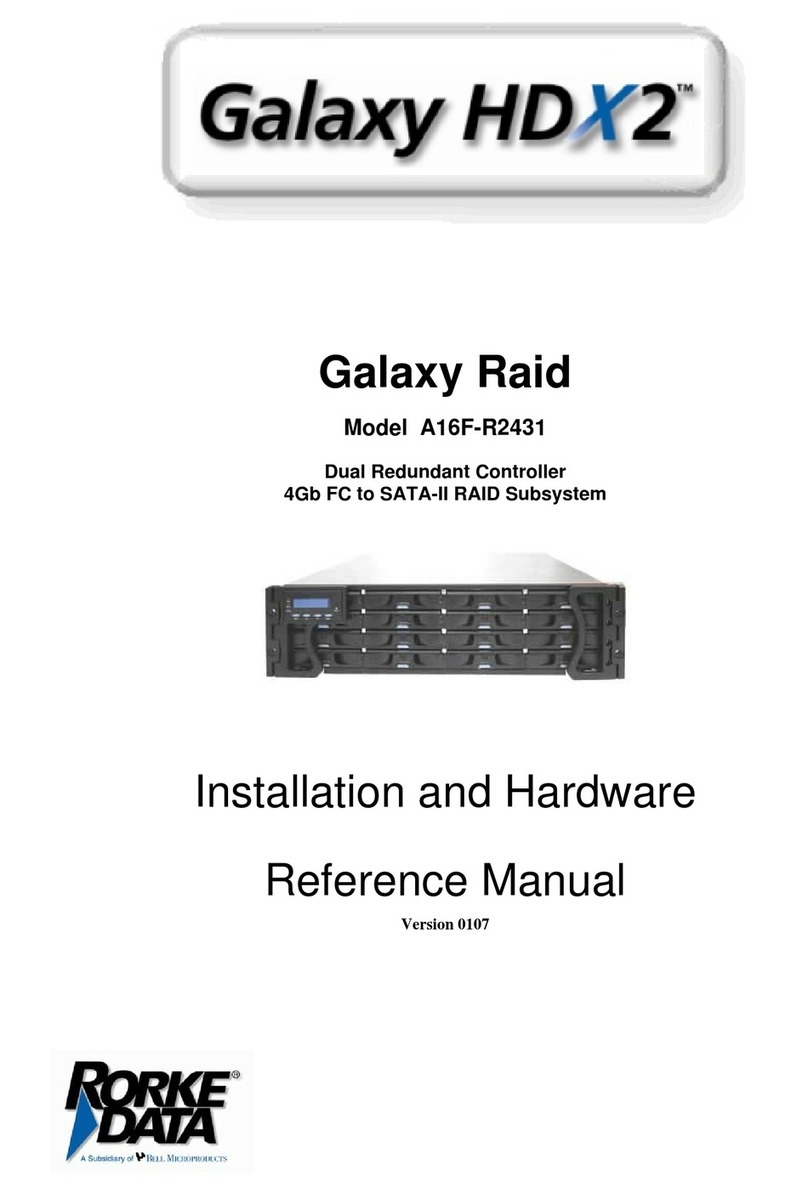
Rorke Data
Rorke Data A16F-R2431 Galaxy Raid User manual
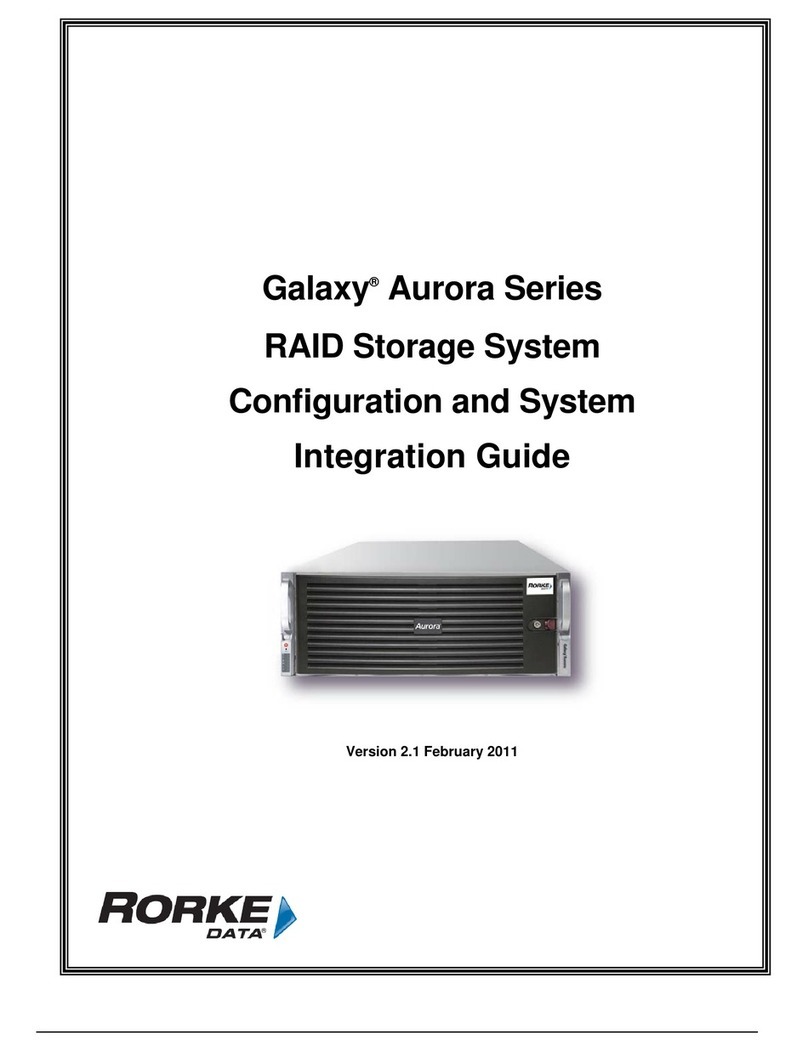
Rorke Data
Rorke Data Galaxy Aurora Series Quick setup guide

Rorke Data
Rorke Data Galaxy Aurora Series Quick setup guide


